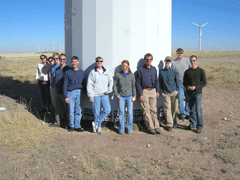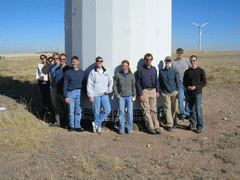Headway on Clean Electricity
Air Date: Week of October 26, 2007

The scale of a modern wind turbine is shown by students from CU Boulder. (Photo: Paul Komor/ Courtesy University of Colorado-Boulder, Environmental Studies)
It took a voter initiative to get clean energy in Colorado. And just three years later, the state has beat its goals. Turns out Colorado is not alone. Tom Plant of the Colorado Governor's Energy office and Alan Nogee of the Union of Concerned Scientists tell us which states are leaders and which lag on clean electricity.
Transcript
GELLERMAN: Kite-generated power may be just a pie in the sky today, but it is a reminder that a lot of folks are looking at ways to stop doing things that aggravate global warming. A prime target of concern is the electric power industry. More than two thirds of electric power in the United States comes from the burning of fossil fuel. And that means power plants put more global warming gases into the air than all of America’s cars, trucks, planes and ships combined.
CURWOOD: In the face of federal inaction, states have been taking the lead in curbing these emissions, including Colorado, where voters passed a measure in 2004 requiring electric utilities to get at least ten percent of their power from renewables. This year, the state went even further.
And with me now to talk about Colorado’s progress on clean energy is the chief of the Governor’s Energy Office, Tom Plant. Welcome Tom.
PLANT: Thank you, Steve. It’s good to be here.
CURWOOD: So tell me, by the end of this year Colorado will be getting how much of its energy cleanly?
PLANT: Well our major utility, Xcel Energy, is going to be getting about ten percent of its total electricity from renewable resources by the end of this year. And that’s the interesting and amazing thing about that is that it’s eight years before the mandated standard that was set up in amendment 37. They said that Xcel needed to get ten percent by 2015 and here we are eight years early and we’re going to be meeting that standard.
CURWOOD: Now, California recently passed legislation prohibiting the purchase in long-term contracts of any dirty electricity. I’m wondering how much this fits into plans in Colorado to build more wind farms.

The scale of a modern wind turbine is shown by students from the CU Boulder Environmental Studies Program. (Photo: Paul Komor/ Courtesy of University of Colorado-Boulder, Environmental Studies)
CURWOOD: You’re not worried about California? First they want your water, now they want your wind?
PLANT: (laughs) Well, wind is one of those things where we have a lot of resource. We don’t have as much demand as we do have resource so we’re more than willing to put it on the wires and get it out to where that demand is.
CURWOOD: So how much untapped wind energy does Colorado still have at this point?
PLANT: Boy, you know, it’s a fantastic question. You know, who knows? We are continuing to see increases in the efficiencies of the turbines. You know, what we thought was maybe one megawatt a few years ago is now producing three megawatts. So, what that production will be in the future we don’t know. But we do know that we have a fantastic resource and we do know that that resource is very widespread throughout the West.
CURWOOD: So, Tom, what advice would you give to advocates and decision makers in other states about how to move the agenda of renewable energy forward?
PLANT: Well, you know, I’d say ‘take Colorado as an example and gain experience from our experience.’ Just a couple of years ago, after four years of failed legislative attempts, the people of Colorado put amendment 37 on the ballot. It established a ten percent renewable electricity standard by 2015, and here we are just a couple of years later, the same utilities—every utility in the state opposed it—and the same utilities that opposed it now went back to the legislature and said ‘we support doubling that standard.’ And it was because many of their assumptions were wrong.
CURWOOD: What were the biggest fears of the energy industry that have now not come to pass?
PLANT: Well, one was that it was going to increase costs for the consumer. In fact, it hasn’t increased costs. The second thing was that it wasn’t going to be producing enough to be able to contribute to the grid—intermittent power wasn’t reliable enough.
CURWOOD: Well, wait a second. The wind only blows some of the time. It’s intermittent energy. Why isn’t that a problem?
PLANT: Well, it’s true that it only blows some of the time but one of the really interesting things that we’re also finding as we study wind development patterns around the West is that there’s not a consistent time when all wind is being produced. For example, if you look at the wind production patterns in southeastern Wyoming, they complement the wind production patterns in southeastern Colorado. So you end up with these offsetting production times which creates a much more stable source of power. I think that’s one of the real challenges for the country as we go forward is broadening this network of transmissions so that we can take advantage of the different times that renewable resources are producing in different areas of the country at different times of the day.
CURWOOD: Well thanks for taking this time with me Tom. Tom Plant is the director of the Energy Office for Colorado Governor Bill Ritter. Thank you so much, Tom.
PLANT: Thank you, Steve.
CURWOOD: Now, Colorado isn’t the only state where renewable energy is beginning to register. New Mexico doubled its clean energy requirement at the same time as Colorado and other states are charging ahead. With me now to provide a national picture is Alan Nogee. He’s director of the Union of Concerned Scientists’ energy division. Thanks for coming in, Alan.
NOGEE: Thanks for having me.
CURWOOD: So I guess if we look at which states have made the most progress, it depends on the number you choose. Let’s start with the goals. Which states are aiming to get the highest percentage of their electricity from clean resources?
NOGEE: Well we now have 25 states plus the District of Columbia that have renewable electricity standards and about a dozen of them are above 20 percent in terms of their requirement. Among the leaders are Minnesota, at 27 percent; California is now 20 percent in law but is considering going to 33 percent and has a state goal of 33 percent; New York’s at 24 percent; and New Jersey and Connecticut up over 20. A growing number of states are looking at meeting or beating 20 percent renewable electricity by the year 2020.
CURWOOD: And then let’s look at the states that are getting already right now to the ten percent level. Who might be ahead of Colorado?
NOGEE: Well Maine is really the national leader because back in the 1970s and early 80’s, they really began developing both their small hydro and their bio energy—their waste wood resources. So Maine is actually about 30 percent today and looking to go higher. After that, you’ve got a number of states that are just into the double digits, including California, New York, and you’ve got a number of states that are meeting or beating their recently enacted renewable electricity standards. There are about a half a dozen states that are on or ahead of schedule in meeting their standards.
CURWOOD: Now, statistics can be played a number of different ways. Let’s look at the absolute amount of power that’s being generated in a clean fashion and in that case, the winner would be?
NOGEE: California has been the leader but in fact, recently, specifically with respect to wind energy, Texas took the lead, as a result of the renewable standard that it enacted in 1999, actually signed by then Governor George W. Bush. Texas has had a huge boom in wind development in the last seven years so we’re there now in the lead from California.
CURWOOD: How many megawatts are we talking about in Texas?
NOGEE: You’ve got about 4,000 megawatts now, I believe. And looking to get to 6,000 and considering raising the standard to 10,000 or 20,000 megawatts.
CURWOOD: So 4,000 of electricity. Is that enough to run San Antonio?
NOGEE: Well I’m not sure off hand how big San Antonio is. One megawatt, a typical small megawatt wind turbine could supply about 250 homes. Nationally, if you look at all of the renewable standards in place, if they achieve their objectives, we could be powering 20 million homes by the year 2020.
CURWOOD: And all this expansion that we’ve been talking about today, this is all essentially wind and--?
NOGEE: It’s primarily wind although also some bio-energy use, landfill gas, there’s new geothermal development happening now in California and the Southwest where you tap the heat deep inside the earth to generate electricity.
CURWOOD: So, your organization, Alan, the Union of Concerned Scientists, tracks the states’ progress on clean energy pretty closely. So as you look at a map of the country—what stands out most for you?
NOGEE: Well what I think what stands out most is there’s still a few regions that really haven’t made much progress, primarily in the Southeast, the Rust Belt, industrial Midwest, and some of the plains and mountain states. We’re starting to fill in the pieces of the map but what we really need is a national standard that sets a minimum requirement for all utilities in the country. And such a standard did pass the House of Representatives over the summer and is up for discussion as the House and the Senate try to reconcile their energy bills.
CURWOOD: Alan, thanks so much for coming into the studio today. Alan Nogee heads up the energy program at the Union of Concerned Scientists in Cambridge, Massachusetts.
NOGEE: Thank you, Steve.
Links
Union of Concerned Scientists: State Clean Energy Maps and Graphs
Living on Earth wants to hear from you!
Living on Earth
62 Calef Highway, Suite 212
Lee, NH 03861
Telephone: 617-287-4121
E-mail: comments@loe.org
Newsletter [Click here]
Donate to Living on Earth!
Living on Earth is an independent media program and relies entirely on contributions from listeners and institutions supporting public service. Please donate now to preserve an independent environmental voice.
NewsletterLiving on Earth offers a weekly delivery of the show's rundown to your mailbox. Sign up for our newsletter today!
 Sailors For The Sea: Be the change you want to sea.
Sailors For The Sea: Be the change you want to sea.
 The Grantham Foundation for the Protection of the Environment: Committed to protecting and improving the health of the global environment.
The Grantham Foundation for the Protection of the Environment: Committed to protecting and improving the health of the global environment.
 Contribute to Living on Earth and receive, as our gift to you, an archival print of one of Mark Seth Lender's extraordinary wildlife photographs. Follow the link to see Mark's current collection of photographs.
Contribute to Living on Earth and receive, as our gift to you, an archival print of one of Mark Seth Lender's extraordinary wildlife photographs. Follow the link to see Mark's current collection of photographs.
 Buy a signed copy of Mark Seth Lender's book Smeagull the Seagull & support Living on Earth
Buy a signed copy of Mark Seth Lender's book Smeagull the Seagull & support Living on Earth

